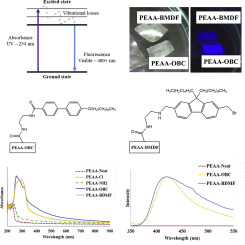Reactive & Functional Polymers ( IF 4.5 ) Pub Date : 2020-04-14 , DOI: 10.1016/j.reactfunctpolym.2020.104598 Ashley Wynne , Jonathan R. Frisch , Collin Britten , Keisha B. Walters

|
Light emission has been introduced onto poly(ethylene-co-acrylic acid) (PEAA) surfaces by covalently grafting two different fluorescent moieties. The facile surface modification method presented allows commercial polymers to be used for light emitting and sensor applications. Two fluorescent compounds, 4′-(octyloxy)-4-biphenyl carboxylic acid (OBC) and 2,7-bis (bromomethyl)-9,9-dihexyl-9H-fluorene (BMDF), were covalently grafted to the surface of PEAA films. Conversion of the carboxylic acid functional group present in PEAA to acid chloride was followed by reaction with ethylenediamine to provide primary amine groups on the film surface. The resultant amine groups then served as the grafting site for OBC and BMDF on the PEAA film (OBC-PEAA and BMDF-PEAA). For each reaction step, the chemical modifications were confirmed using FTIR spectroscopy and static water contact angles. OCB-PEAA and BMDF-PEAA films were evaluated using UV–Vis spectrophotometry to determine UV absorption wavelength ranges. The modified films were then irradiated at their respective maximum absorption wavelengths in a fluorescence spectrophotometer and emissions were identified in both the violet-blue and red regions of visible light. When irradiated at 254 nm, both PEAA-OBC and PEAA-BMDF fluoresce blue. Films were reanalyzed after 6 months and again after 5 years to assess long-term stability of this light emitting behavior. OBC and BMDF grafted to the PEAA films remained chemically stable and functioned effectively as light emitting polymer films for up to 5 years.
中文翻译:

用荧光部分表面官能化的聚(乙烯-共-丙烯酸)薄膜的合成,表征和稳定性
发光已经被引入到聚(乙烯-共(丙烯酸)(PEAA)表面通过共价接枝两个不同的荧光部分。提出的简便的表面改性方法允许将商用聚合物用于发光和传感器应用。将两种荧光化合物4'-(辛氧基)-4-联苯羧酸(OBC)和2,7-双(溴甲基)-9,9-二己基-9H-芴(BMDF)共价接枝到PEAA表面电影。将PEAA中存在的羧酸官能团转化为酰氯,然后与乙二胺反应,在膜表面提供伯胺基。然后,所得的胺基充当PEAA膜(OBC-PEAA和BMDF-PEAA)上OBC和BMDF的接枝位点。对于每个反应步骤,使用FTIR光谱和静态水接触角确认化学修饰。使用UV-Vis分光光度法评估OCB-PEAA和BMDF-PEAA膜,以确定UV吸收波长范围。然后在荧光分光光度计中以它们各自的最大吸收波长辐照改性的薄膜,并在可见光的紫蓝色和红色区域中识别出发射。当在254 nm处照射时,PEAA-OBC和PEAA-BMDF都发出蓝色荧光。在6个月后和5年后再次分析膜,以评估这种发光行为的长期稳定性。接枝到PEAA膜上的OBC和BMDF在化学上保持稳定,并可以有效用作发光聚合物膜长达5年。然后在荧光分光光度计中以它们各自的最大吸收波长辐照改性膜,并在可见光的紫蓝和红区域中识别出发射。当在254 nm处照射时,PEAA-OBC和PEAA-BMDF都发出蓝色荧光。在6个月后和5年后再次分析膜,以评估这种发光行为的长期稳定性。接枝到PEAA膜上的OBC和BMDF在化学上保持稳定,并可以有效用作发光聚合物膜长达5年。然后在荧光分光光度计中以它们各自的最大吸收波长辐照改性的薄膜,并在可见光的紫蓝色和红色区域中识别出发射。当在254 nm处照射时,PEAA-OBC和PEAA-BMDF都发出蓝色荧光。在6个月后和5年后再次分析膜,以评估这种发光行为的长期稳定性。接枝到PEAA膜上的OBC和BMDF在化学上保持稳定,并可以有效用作发光聚合物膜长达5年。在6个月后和5年后再次分析膜,以评估这种发光行为的长期稳定性。接枝到PEAA膜上的OBC和BMDF在化学上保持稳定,并可以有效用作发光聚合物膜长达5年。在6个月后和5年后再次分析膜,以评估这种发光行为的长期稳定性。接枝到PEAA膜上的OBC和BMDF在化学上保持稳定,并可以有效用作发光聚合物膜长达5年。







































 京公网安备 11010802027423号
京公网安备 11010802027423号